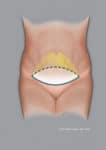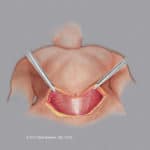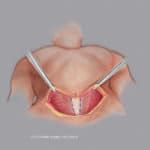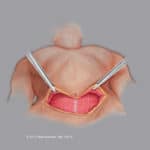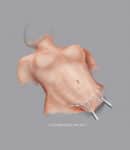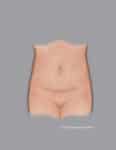At our Hauppauge office, Dr. Mark D. Epstein offers cutting-edge mini-abdominnoplasty procedures for patients seeking to restore their physique and regain the beautiful body of their youth. If you wish to learn about the benefits of a mini-abdominoplasty, call us today at 631.689.1100 and learn how Dr. Epstein can offer you the latest techniques and personalized care!
What Is A Mini-Abdominoplasty?
A mini-abdominoplasty is similar to a standard abdominoplasty with a few differences. Like the latter, the mini-abdominoplasty uses a waist crease incision but often (but not always depending upon the amount of skin to be removed) the incision is not quite as long as with the standard procedure. A shorter incision does not mean you will heal faster or have a shorter recovery, the difference in incision length is not enough to make such a difference. Wounds heal side to side, not end to end, so a shorter incision heals in the same time as a longer incision. There are some other substantial differences. There is no incision made around the umbilicus, and it is for this reason that when the skin is lifted up off the abdominal wall, it is only to the level of the umbilicus. As only the lower abdominal wall is exposed, only the lower abdominal muscles can be tightened.
There is a variety of abdominoplasty procedure where the umbilicus is left intact on the outside skin but cut at its base from the abdominal wall. This is called floating the “umbilicus”. In this procedure, the umbilicus is left intact to the surrounding skin on the outside, but as the abdominal skin is lifted upwards off the abdominal wall, when the umbilicus is encountered, it is transected (cut) from its attachment down below on the abdominal wall. Now the umbilicus floats upward off the abdominal wall, remaining attached to the abdominal skin. This will allow the surgeon access to the upper abdominal muscles for tightening. This is a fantastic procedure but is limited to the rare situation when there is abdominal muscle laxity but minimal to no upper abdominal skin excess. As the abdominal skin is pulled downwards to the pelvis, so does the position of the umbilicus. Lastly, when the abdominal wound is closed, the umbilicus may be pulled down slightly, usually no more than a centimeter or so, and this doesn’t appear to cause any concern in my experience. Patient selection is critical, as if this procedure is performed on a patient with too much upper abdominal skin laxity, the umbilicus will end up too low on the abdomen which will not look good.
What Is the Difference Between a Mini-Abdominoplasty and a Traditional Abdominoplasty?
A mini-abdominoplasty and a traditional abdominoplasty remove excess skin and tighten muscle tissue, flattening the abdomen. However, the two procedures vary in the treatment area and the scope of treatment.
A traditional abdominoplasty targets the entire abdominal area above and below the navel. As part of the procedure, the surgeon repairs abdominal muscles in the mid and upper abdomen that frequently separate during pregnancy, called diastasis recti.
Additionally, the incision for a traditional abdominoplasty is more extensive, generally extending hip-to-hip, though it still sits low on the abdomen, just above the pubic bone. Skin is pulled down to the incision area, making it tighter and reducing or eliminating stretch marks.
Traditional abdominoplasty may include liposuction and require the creation of a new belly button.
In a mini-abdominoplasty, the incision is still low, but 6-12 inches shorter, and the procedure only targets any loose skin and muscle tissue below the belly button.
Who Is An Ideal Candidate For A Mini-Abdominoplasty?
The best candidates for a mini-abdominoplasty are men and women with belly fat or excess skin centralized under the navel. Additionally, ideal patients are otherwise fit and in good health.
Since a mini-abdominoplasty does not repair diastasis recti, those with lax muscles above the navel may need to opt for a full abdominoplasty.
The Steps in Performing a Mini-Abdominoplasty
Step 1
The blue ellipse indicates the proposed amount of skin to be removed. The lower solid blue line is where the initial incision is made. The dotted blue line is the proposed upper portion of the skin excision (removal). This can vary upwards or downwards depending upon how much skin excess exists. In this procedure, there is no incision made around the umbilicus. The umbilicus remains attached to the underlying abdominal muscles as well as to the remaining abdominal skin. There will not be a circular hole in the skin flap. The yellow area shows the extent to which the abdominal skin is elevated off the abdominal wall.
Step 2
The abdominal skin is elevated off the abdominal wall, the abdominal musculature is revealed. The skin is elevated to just below the umbilicus in the midline, a little higher to either side of the umbilicus so as to maintain the attachment of the umbilicus to the abdominal wall.
Step 3
The abdominal wall musculature is tightened using a special running suture. The muscles are brought together in the midline.
Step 5
The excess skin is elevated above the abdominal wall and pulled downward. The area of resection (removal) is indicated with a dotted line. There is no hole in the abdominal skin flap because there was no incision made around the umbilicus.
How Do I Prepare for My Mini-Abdominoplasty?
Before a mini-abdominoplasty, patients may need to eliminate certain medications and supplements, as advised by their surgeon. In addition, those who smoke should quit at least four weeks before their procedure, as smoking impairs healing.
Patients will also need to prepare a recovery area and gather supplies such as a compression garment and any post-surgical medication they may need. In addition, patients who prioritize healthy eating and hydration before their procedure often experience a faster recovery.
What Is the Recovery and Aftercare for the Mini-Abdominoplasty Procedure?
Recovery from any surgery varies depending on the patient’s health, age, and activity level. Those in good health, whose abdominal muscles didn’t need much adjustment, can heal as quickly as two weeks after surgery.
After a mini-abdominoplasty procedure, patients wear a compression garment around the waist for two to three weeks to keep the area tight, reduce swelling, and preserve the procedure results.
Bed rest after a mini-abdominoplasty is unnecessary, and walking after the procedure is encouraged to maintain fitness and reduce blood clots.
However, patients should avoid strenuous exercise until about six weeks post-surgery and ought to ease back into their fitness routine. Most patients who work a desk or office job can return to work in about a week.
How Soon After the Procedure Will I See the Results of My Mini-Abdominoplasty?
Immediately after a mini-abdominoplasty procedure, loose, sagging skin is gone. However, there will be some swelling, which will worsen, and then gradually decrease over the next several weeks.
About three to four months after the procedure, all swelling should be gone, and patients will be able to fit into smaller clothing and enjoy their results fully. Incisions will continue to fade for about the first year after an abdominoplasty. Applying scar cream and avoiding sun exposure during this time will reduce scarring.
ABDOMINOPLASTY FAQS
- Introduction
- What is an Abdominoplasty?
- How is an Abdominoplasty Performed?
- The Different Types Of Abdominoplasty
- Combination VASER/PAL HI-Definition Lipo-Abdominoplasty
- The Recovery – The Way I Do It Now…
- The Recovery – The Way It is Usually Done…
- As You Heal
- Why Do We Need Different Types Of Abdominoplasty?
- Standard Abdominoplasty With “Umbilical Re-Positioning”
- Standard Abdominoplasty with a “Floated Umbilicus”
- Mini-Abdominoplasty
- Extended Abdominoplasty
- Circumferential Abdominoplasty “Belt-lipectomy”
- Flowchart – How to Select an Abdominoplasty Procedure
Chapters – Abdominoplasty Guide
Schedule Your Mini-Abdominoplasty Consultation In Hauppauge!
Interested in the mini-abdominoplasty procedure and are seeking to learn whether you are a candidate for treatment? Be sure to give us a call at (631) 689-1100 today to schedule a one-on-one consultation with Dr. Mark D. Epstein to get the information you need! You can also fill out the form in our contact page for your personalized appointment. Our practice looks forward to serving you!


